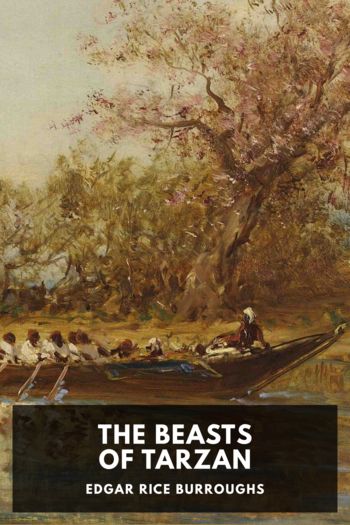Short Fiction, Edgar Allan Poe [best autobiographies to read TXT] 📗

- Author: Edgar Allan Poe
Book online «Short Fiction, Edgar Allan Poe [best autobiographies to read TXT] 📗». Author Edgar Allan Poe
The visitor, shooting suddenly into this bay from out the gloom of the ravine, is delighted but astounded by the full orb of the declining sun, which he had supposed to be already far below the horizon, but which now confronts him, and forms the sole termination of an otherwise limitless vista seen through another chasm-like rift in the hills.
But here the voyager quits the vessel which has borne him so far, and descends into a light canoe of ivory, stained with arabesque devices in vivid scarlet, both within and without. The poop and beak of this boat arise high above the water, with sharp points, so that the general form is that of an irregular crescent. It lies on the surface of the bay with the proud grace of a swan. On its ermined floor reposes a single feathery paddle of satinwood; but no oarsmen or attendant is to be seen. The guest is bidden to be of good cheer—that the fates will take care of him. The larger vessel disappears, and he is left alone in the canoe, which lies apparently motionless in the middle of the lake. While he considers what course to pursue, however, he becomes aware of a gentle movement in the fairy bark. It slowly swings itself around until its prow points toward the sun. It advances with a gentle but gradually accelerated velocity, while the slight ripples it creates seem to break about the ivory side in divinest melody—seem to offer the only possible explanation of the soothing yet melancholy music for whose unseen origin the bewildered voyager looks around him in vain.
The canoe steadily proceeds, and the rocky gate of the vista is approached, so that its depths can be more distinctly seen. To the right arise a chain of lofty hills rudely and luxuriantly wooded. It is observed, however, that the trait of exquisite cleanness where the bank dips into the water, still prevails. There is not one token of the usual river debris. To the left the character of the scene is softer and more obviously artificial. Here the bank slopes upward from the stream in a very gentle ascent, forming a broad sward of grass of a texture resembling nothing so much as velvet, and of a brilliancy of green which would bear comparison with the tint of the purest emerald. This plateau varies in width from ten to three hundred yards; reaching from the riverbank to a wall, fifty feet high, which extends, in an infinity of curves, but following the general direction of the river, until lost in the distance to the westward. This wall is of one continuous rock, and has been formed by cutting perpendicularly the once rugged precipice of the stream’s southern bank, but no trace of the labor has been suffered to remain. The chiselled stone has the hue of ages, and is profusely overhung and overspread with the ivy, the coral honeysuckle, the eglantine, and the clematis. The uniformity of the top and bottom lines of the wall is fully relieved by occasional trees of gigantic height, growing singly or in small groups, both along the plateau and in the domain behind the wall, but in close proximity to it; so that frequent limbs (of the black walnut especially) reach over and dip their pendent extremities into the water. Farther back within the domain, the vision is impeded by an impenetrable screen of foliage.
These things are observed during the canoe’s gradual approach to what I have called the gate of the vista. On drawing nearer to this, however, its chasm-like appearance vanishes; a new outlet from the bay is discovered to the left—in which direction the wall is also seen to sweep, still following the general course of the stream. Down this new opening the eye cannot penetrate very far; for the stream, accompanied by the wall, still bends to the left, until both are swallowed up by the leaves.
The boat, nevertheless, glides magically into the winding channel; and here the shore opposite the wall is found to resemble that opposite the wall in the straight vista. Lofty hills, rising occasionally into mountains, and covered with vegetation in wild luxuriance, still shut in the scene.
Floating gently onward, but with a velocity slightly augmented, the voyager, after many short turns, finds his progress apparently barred by a gigantic gate or rather door of burnished gold, elaborately carved and fretted, and reflecting the direct rays of the now fast-sinking sun with an effulgence that seems to wreath the whole surrounding forest in flames. This gate is inserted in the lofty wall; which here appears to cross the river at right angles. In a few moments, however, it is seen that the main body of the water still sweeps in a gentle and extensive curve to the left, the wall following it as before, while a stream of considerable volume, diverging from the principal one, makes its





Comments (0)